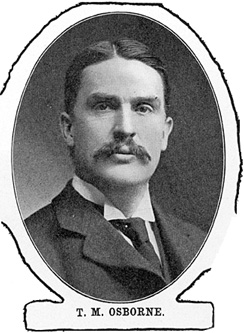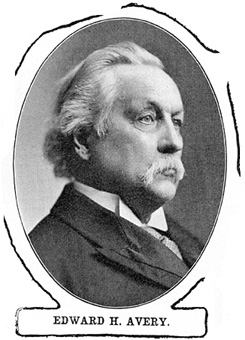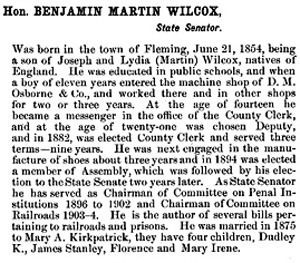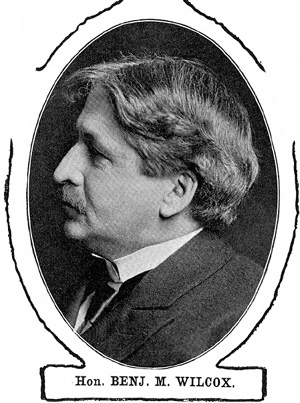|

The above is a detail from a Hecht scan of one of a series of pages presenting biographical sketches and photo images of prominent leaders in the Cayuga County, NY, community of 1904.
Hecht's scans of "Men of Affairs and Professions" are from part of a 1904 Atlas Map Book titled The New Century Atlas Of Cayuga County New York. The Atlas Book was originally published by the Century Map Company, Otto Barthel Chief Engineer, Philadelphia in 1904.
What follows is a selective sampling of those pages, with certain details particularly underscored from a correction history-related perspective. A more generalized thumbnails interface to the "Men Of Affairs And Professions" section of The New Century Atlas of Cayuga County, New York 1904 is available on the Cayuga County NYGenWeb Project site.
Several of the 1904 atlas biographical pages are quite gender specific, referring to Men of Affairs and Professions. Only one page dropped the gender reference and included a photo and brief bio note on a woman: Mrs. Susan Olmsted, owner of "Twin Pines," a prominent homestead in Fleming. Others whose portraits and bio notes appear together on that page, simply entitled Sketches and Portraits -- Continued, include: 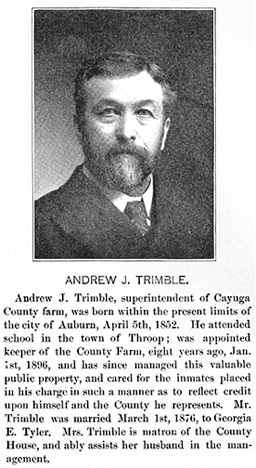
- Andrew J. Trimble, (right) manager of the County Farm. In the 19th and into the 20th century, county farms were poorhouses with rural atmosphere. Able-body males worked the fields. Such farms were seen as being advantageous, even though -- or perhaps because -- their sites were often situated a regions quite remote from commerical, cultural and governmental centers as well as removed from the more affluent residental areas.
The report on Cayuga County in the 1860 French's Gazetteer of the State of New York, transcribed by Steve and Pat McKay in July 1997, noted: "The county poorhouse is located upon a
farm of 90 acres in Sennett, 3 mi. N.E. of Auburn. It is a poor, old dilapidated building, containing about 30 rooms. The average number of inmates is about 100, supported at a weekly cost of 70 cts. Each."
For a report on the conditions of the county farm in 1857, go to The Poorhouse Lady's site.
The historical linkage and proximity of public facilities for paupers and prisoners evident elsehwere in state and nation holds true in Cayuga. Though the nomenclature has changed, the county nursing home and county jail as well as the sheriff's office are situated on County House Road. The Cayuga County Farm Cemetery is located off County House Road, Town of Sennett.
Elsewhere on this NYCHS site, Auburn Prison historian John Miskell notes in his monograph Why Auburn that after the 1929 riots some Auburnians wanted the prison dismantled and reconstructed on a 225-acre site owned by the state in the Town of Sennett that included
the site selected of the prison farm which had been established in 1917. Pine Ridge Road off of U.S. 20 is also known as Prison Farm Road.
- Joseph P. Koon, whose widow Cora was Mrs. Olmsted's daughter.
- E. M. Sperry, prosperous farmer.
- Herbert Lewis, dairy farmer.
- Henry Tosh, who succeeded in many diverse business and farm-related ventures.
- William Koenig, brewer.
- H.D. Bowen, orchards owner.
- W. S. Bowen.
- Fred Dixon, Town of Sennet farmer.
The original 1.8 Mb digital image Hecht created from the Sketches and Portraits -- Continued page scan has a dpi of 96 and measures more than 22 inches wide and nearly 26 inches high. For the complete image, click on County Farm manager Trimble's portrait (above right) or on the full page's URL:
http://freepages.genealogy.rootsweb.com/~springport/pictures49/4961.jpg
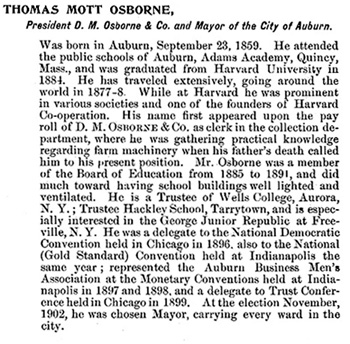 The text image right, showing a brief biographical sketch of prison reformer Thomas Mott Osborne, is a greatly downsized detail from one of the Men of Affairs and Professions pages. His family name is part of the Auburn&Osborne title for the NYCHS special web section you are currently visiting where about 85 pages carry references to him, his family, his career, his reforms and the organizations he founded or inspired. Auburn&Osborne section presentations include The text image right, showing a brief biographical sketch of prison reformer Thomas Mott Osborne, is a greatly downsized detail from one of the Men of Affairs and Professions pages. His family name is part of the Auburn&Osborne title for the NYCHS special web section you are currently visiting where about 85 pages carry references to him, his family, his career, his reforms and the organizations he founded or inspired. Auburn&Osborne section presentations include
The other men whose bio sketches appear on that same page are:
The original 2.3 Mb digital image Hecht created from scanning the Men of Affairs and Professions page (that presented bio sketches of Thomas Mott Osborne, Edward H. Avery and the others named above) has a dpi of 96 and measures more than 22 inches wide and nearly 27 inches high. For the complete image, click on the Thomas Mott Osborne bio text image (above right) or on the full page's URL:
http://freepages.genealogy.rootsweb.com/
~springport/pictures49/4952.jpg
(if typing, enter web address as one word)
In the original publication, Photographic Reproductions of Men of Affairs and Professions appeared on a separate page (104) opposite the biographical texts page (105). The original 1.6 Mb digital image Hecht created from scanning the Photographic Reproductions of Men of Affairs and Professions page (that presented photo portraits of Thomas Mott Osborne, Edward H. Avery and the others named above) has a dpi of 96 and measures nearly 18 inches wide and more than 26 inches high. For the complete page image, click on either the Thomas Mott Osborne or Charles H. Avery B&W head&shoulders image (above right) or on the full page's URL:
http://freepages.genealogy.rootsweb.com/~springport/pictures48/00004842.jpg
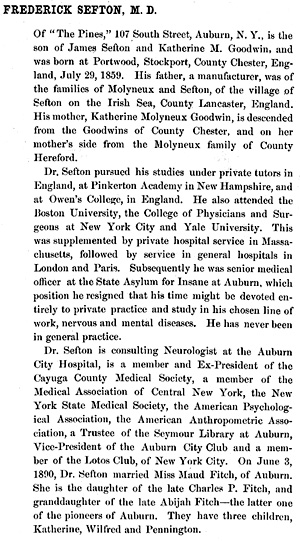 The bio text image right, concerning Dr. Frederick Shefton, is a greatly reduced detail from yet another of the Men of Affairs and Professions pages scanned by Hecht. The bio text image right, concerning Dr. Frederick Shefton, is a greatly reduced detail from yet another of the Men of Affairs and Professions pages scanned by Hecht.
The brief biological sketch on Dr. Shefton notes his former service as senior medical officer at the State Asylum for the Insane at Auburn.
Before operation of the Lunatic Asylum for Insane Convicts moved in 1892-1894 to Fishkill where it became known as the Matteawan State Hospital for the Criminally Insane, it had been at Auburn from 1859 -- the state's first such mental hospital/prison. The Auburn facilities it had used were then converted into a women's prison. That operation continued until 1934 when it moved to Bedford Hills. The century-old buildings
were demolished in 1958 to make way for a new educational building later called the Osborne School.
The other men whose bio sketches appear on that same page are:
- Merritt D. Greene, lumber dealer.
- John Hermon Woodruff, Auburn Button Works propreitor.
- Rev. William Mulheron, pastor, St. Mary's Parish.
- Edward T. Kelley, president Independent Brewing Company.
- Saffrene L. Depew, Board of Supervisors ex-chairman.
- William J. McMaster, NY Life Insurance agent.
- Frank C. Smith, M.D.
- Harrison L. Hoyt, real estate and insurance.
- Ernest G. Tabor, Supervisor.
- John G. Marshall, Auburn Extract Co. president.
- John Joseph Gardner, contractor and paints dealer.
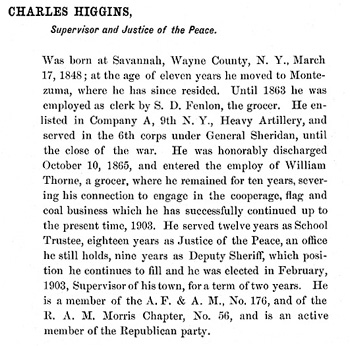
- Lewis F. Leonard, coal dealer.
- Levi T. Hamilton, Ex-supervisor.
- J. G. Whitmee, Supervisor.
- Thos. F. Dignum, Osborne House propreitor.
- Dr. William Hughes, dentist.
- Frank Parsons, farmer and stock raiser.
- J.K. Bust, carriage dealer.
- Charles Higgins, Supervisor and Justice of Peace. His bio sketch (right) makes mention of his being, all at the same time, the J.P., a Supervisor, and a Deputy Sheriff, an interesting combination of offices being held by the same person.
The original 1.7 Mb digital image Hecht created from scanning the Men of Affairs and Professions page (that presented bio sketches of Dr. Frederick Shefton, Charles Higgins and the others named above) has a dpi of 96 and measures more than 22 inches wide and nearly 27 inches high. For the complete image, click on the Dr. Frederick Shefton or Charles Higgins bio text image (above right) or on the full page's URL:
http://freepages.genealogy.rootsweb.com~springport/pictures49/4959.jpg
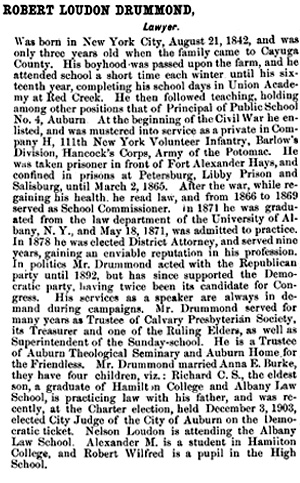 The bio text image right, concerning Robert Loudon Drummond, is a greatly reduced detail from still another of the Men of Affairs and Professions pages scanned by Bill Hecht. The bio text image right, concerning Robert Loudon Drummond, is a greatly reduced detail from still another of the Men of Affairs and Professions pages scanned by Bill Hecht.
The brief biographical sketch on Drummond notes his service as trustee of the Home for the Friendless in Auburn. Unlike facilities with that euphemistic name in New York City and Rochester, this "group home" at 46 Grant Avenue, Auburn, had been started in the early 1870s to help Civil War widows and their children.
New York City's Home for the Friendless had been founded in the mid-1830s by the ladies of the New York Female Moral Reform Society with offices at 29 East 28th St. Similarly, the Rochester community in 1850 set up a Home for the Friendless as a jail alternative for prostitutes.
His involvement in post-Civil War related charitable work had special meaning for him. A Union soldier with NY's 111th Volunteer Infantry that had been organized by then Colonel/later General Jesse Segoine of Auburn, Drummond and others of the regiment became POWs during the Richmond-Petersburg campaign in October, 1864. They spent the next five months trying to survive conditions at two Confederacy hellholes: Libby Prison in Virginia and Salisbury Prison in North Carolina.
How Drummond's religious faith helped him through the experience and how the experience deepened his religious faith is retold in The Religious Pray, The Profane Swear: A Civil War Memoir.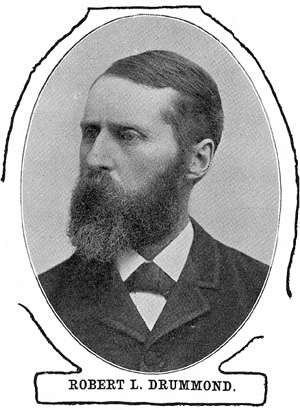
It's a retelling because York College of Pennsylvania Professor Victor E. Taylor has taken Drummond's own little-known manuscript Personal Reminiscences of Prison Life During the War of the Rebellion and, without altering it, provided additional context, biographic and historical details, enhancing and revealing its real import as a story of the human spirit's struggle against humankind's own inhumanity.
How a Syracuse University class discussion about the Cayuga Museum of Art and History in Auburn led Taylor to take an interest in the Drummond manuscript is itself an interesting story told in the April 13, 2003 York Daily Record by Lori Badders and by a York College of Pennsylvania press announcement March 25, 2003. The Cayuga Museum's archives has a considerable amount of information and artifacts from Mr. Drummond's personal collection and its shop carries the book. Mr. Drummon's son headed the historic society for many years. Auburn has a street named Drummond Street where his farm used to be.
"The Home" -- as many Auburnians call it -- is still operating on Grant Avenue in Auburn, but as an assisted living facility for senior citizens. Cayuga Museum presents programs there.
The other men whose bio sketches appear on that same page are:
The original 2.2 Mb digital image Hecht created from scanning the Men of Affairs and Professions page (that presented bio sketches of Robert Loudon Drummond, State Senator Benjamin Martin Wilcox and the others named above) has a dpi of 96 and measures more than 22 inches wide and nearly 27 inches high. For the complete image, click on the Robert Loudon Drummond or tate Senator Benjamin Martin Wilcox bio text image (above right) or on the full page's URL:
http://freepages.genealogy.rootsweb.com~springport/pictures49/4951.jpg
The original 1.6 Mb digital image Hecht created from scanning the Photographic Reproductions of Men of Affairs and Professions page (that presented photo portraits of Robert Loudon Drummond, State Senator Benjamin Martin Wilcox and the others named above) has a dpi of 96 and measures nearly 18 inches wide and more than 26 inches high. In the original publication, Photographic Reproductions of Men of Affairs and Professions appeared on a separate page (107) opposite the biographical texts page (106). For the complete page 107 image, click on either the Robert Loudon Drummond or State Senator Benjamin Martin Wilcox B&W head&shoulders image (above right) or on the full page's URL:
http://freepages.genealogy.rootsweb.com/~springport/pictures49/4953.jpg
These digital images are copyrighted to William S. Hecht 2001 © and may be viewed and copied freely for non-comerical personal genealogy and family history research only.
|




